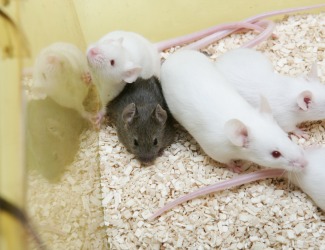Drug reduces fear caused by previous traumatic experiences in mice

Mice previously exposed to traumatic situations demonstrate a stronger ability to react to fear conditioning - acquired by associating a sonorous stimulus with an aversive stimulus - and lack the ability to inhibit this fear. This phenomenon is similar to that of people who suffer from Post-Traumatic Stress Disorder (PTSD), an anxiety disorder which appears after being exposed to highly traumatic situations, such as a violent attack, a natural disaster or physical abuse.
In the study researchers verified that the 7,8-Dihydroxyflavone dosis injected into mice who had undergone a traumatic experience made them eliminate fear conditioning quicker. The boost in this new behaviour is the result of 7,8-Dihydroxyflavone activating the TrkB receptors in the brain, probably those found in the amygdala, which are essential for emotional learning and memory.
7.8-Dihydroxyflavone is a type of flavonoid. These chemical compounds are present in our diets in elements such as red wine, citrus, cereals, tea and chocolate (at least 70% cocoa), etc. Chronic administration of foods rich in flavonoids in lab animals has demonstrated neuroprotective effects in long-living rodents, but the activation of TrkB receptors produced by these foods is surely low compared to the effects of 7,8-Dihydroxyflavone.
TrkB receptors in the brain are activated in mammals with the BDNF protein. There are different pathologies, such as depression or anxiety disorders, in which this protein shows alterations in its expression. Unfortunately, administration of the BDNF protein as a drug is limited given that a large part of the amount injected does not permeate the blood-brain barrier and cannot access the brain. Very recent studies have demonstrated that 7,8-Dihydroxyflavone is the first drug to imitate BDNF actions and enter the brain with much more efficacy than the same protein, thus revealing therapeutic actions in animal models suffering from Alzheimer's, strokes, Parkinson's and/or depression.
The results obtained in this study postulate that 7,8-Dihydroxyflavone as a drug could be useful as a treatment of disorders based on fear, such as PTSD, panic attacks and phobias. Researchers consider it convenient to study its effects combined with psychotherapy, administrating the drug in fear elimination therapy sessions for anxiety disorders or even shortly after a person experiences a traumatic situation.
Led by Dr Kerry Ressler of Emory University, Atlanta, the study was developed with the participation of Dr Antonio Armario, researcher at the Institute of Neuroscience of the UAB and professor of the Department of Cell Biology, Physiology and Immunology, and Dr Raul Andero, researcher at the Emory University. The article published in the American Journal of Psychiatry is part of Dr Andero's doctoral thesis.
References
"Effect of 7,8-Dihydroxyflavone, a Small-Molecule TrkB Agonist, on Emotional Learning". Raul Andero, Scott A. Heldt, Keqiang Ye, Xia Liu, Antonio Armario, Kerry J. Ressler. Am J Psychiatry, December 1, 2010, doi: 10.1176/appi.ajp.2010.10030326.


